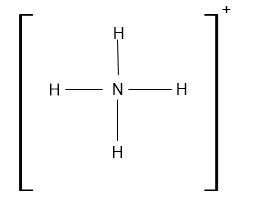
Interpretation:
The structure of
Concept introduction:
Lewis structure can be shown by each atom in the molecule using the chemical symbol with the electrons. The bond is formed by sharing of valence electrons between the atoms and excess electron is shown as lone pair.
Answer to Problem 41PP

Explanation of Solution
Lewis structure of
First write the electron configuration of nitrogen and hydrogen as follows:
Nitrogen (N)
H
As
For the valence shell configuration nitrogen requires
The structure is represented as follows:

After sharing the electron between the nitrogen and hydrogen atoms, the stable valance shell configuration can be obtained.
The valence shell configuration can be achieved by sharing the valence electron between the atoms.
Chapter 8 Solutions
Chemistry: Matter and Change
Additional Science Textbook Solutions
CHEMISTRY-TEXT
Chemistry: Structure and Properties (2nd Edition)
Organic Chemistry (8th Edition)
Introductory Chemistry (5th Edition) (Standalone Book)
Organic Chemistry (9th Edition)
Chemistry: The Central Science (14th Edition)
 ChemistryChemistryISBN:9781305957404Author:Steven S. Zumdahl, Susan A. Zumdahl, Donald J. DeCostePublisher:Cengage Learning
ChemistryChemistryISBN:9781305957404Author:Steven S. Zumdahl, Susan A. Zumdahl, Donald J. DeCostePublisher:Cengage Learning ChemistryChemistryISBN:9781259911156Author:Raymond Chang Dr., Jason Overby ProfessorPublisher:McGraw-Hill Education
ChemistryChemistryISBN:9781259911156Author:Raymond Chang Dr., Jason Overby ProfessorPublisher:McGraw-Hill Education Principles of Instrumental AnalysisChemistryISBN:9781305577213Author:Douglas A. Skoog, F. James Holler, Stanley R. CrouchPublisher:Cengage Learning
Principles of Instrumental AnalysisChemistryISBN:9781305577213Author:Douglas A. Skoog, F. James Holler, Stanley R. CrouchPublisher:Cengage Learning Organic ChemistryChemistryISBN:9780078021558Author:Janice Gorzynski Smith Dr.Publisher:McGraw-Hill Education
Organic ChemistryChemistryISBN:9780078021558Author:Janice Gorzynski Smith Dr.Publisher:McGraw-Hill Education Chemistry: Principles and ReactionsChemistryISBN:9781305079373Author:William L. Masterton, Cecile N. HurleyPublisher:Cengage Learning
Chemistry: Principles and ReactionsChemistryISBN:9781305079373Author:William L. Masterton, Cecile N. HurleyPublisher:Cengage Learning Elementary Principles of Chemical Processes, Bind...ChemistryISBN:9781118431221Author:Richard M. Felder, Ronald W. Rousseau, Lisa G. BullardPublisher:WILEY
Elementary Principles of Chemical Processes, Bind...ChemistryISBN:9781118431221Author:Richard M. Felder, Ronald W. Rousseau, Lisa G. BullardPublisher:WILEY





